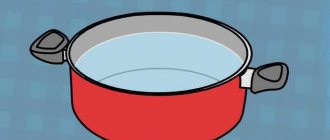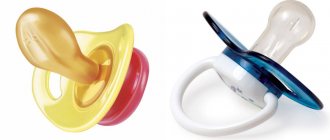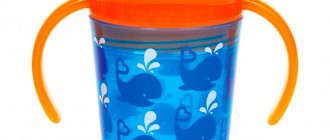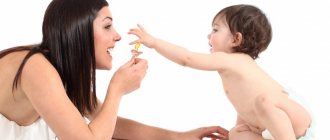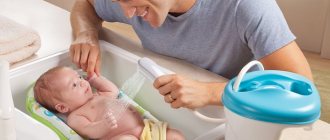For physiological reasons, a small child from birth to one and a half years old needs to constantly suck something. It could be the mother's breast, a finger, a fist or a toy, but most often modern parents use a pacifier for these purposes. It can be difficult to decide on the best option the first time - first you need to try different options for pacifiers to understand which one suits your child best.
As for the criteria for choosing a pacifier, the following stand out among them:
- baby's weight and size – pacifiers are typically designed for 0-6 months (size A or 1), 6-12 months (B or 2) and 12 to 18 months (C or 3) as baby grows and needs change ;
- shape - it can be round, symmetrical, anatomical, and here you need to see which one your baby likes best;
- size of the holder - it should be large enough, but not too large, not have unnecessary decorations and not irritate the baby’s delicate skin;
- safety - the pacifier should not be chewed, broken or taken apart;
- material - latex or silicone, latex is natural and wears out faster, but synthetic silicone can last quite a long time;
- manufacturer - after all, well-known brands guarantee the quality of their products, while little-known ones cannot guarantee you anything, so why take the risk?
Below we bring to your attention the TOP 10 main manufacturers (brands) of pacifiers that you can find on the children's goods market. Manufacturer, features, properties, advantages and disadvantages, price - these are the parameters we will touch on in the review.
Nuk Genius – German quality
Nuk Genius is a German-made pacifier. The sucking part has a special ortho-shape - it is slightly flattened and comes with a special indentation that prevents the pacifier from falling out of the baby's mouth. Can shrink without sticking together, available in three sizes.
Pros:
- "smart" air valve;
- "healthy" form;
- softness;
- durability;
- materials latex and silicone to choose from.
Minus:
- not a small price.
The cost of a pacifier (average) is 280 rubles.
Nuances of product care
In addition to washing and boiling the pacifier in various ways, during use there is a need to soften the pacifier or enlarge it . To do this, you need to put the product in a container with water, bring to a boil and “cook” for 5-7 minutes. Leave to cool in boiling water, being careful not to melt it.
How often the pacifier will need to be changed depends on the material. Latex accessories last from 2 to 4 weeks, the “life” of silicone pacifiers is 1-1.5 months, a rubber pacifier requires replacement after two months of use;
How to choose the right pacifier (material, shape, size) and which ones are best, read our article.
During the day, it is recommended to wash the pacifier several times in water with baby detergent and rinse thoroughly. It is useful to have 2-3 replacements while some are being sterilized.
Attention! Special holders and containers will help avoid frequent dropping of the pacifier on the floor and the need for further disinfection.
Pigeon – focus on naturalness
The Japanese pacifier is intended strictly for newborn babies aged 0-4 months. It has an unusual shape (flattened in the middle part) and is orthodontic. Ideal value for money.
Pros:
- inexpensive;
- quality;
- has a beautiful design (designs include stars, cars, flowers).
Minuses:
- No.
The average cost is 150 rubles.
Flaws
Worms in a child - how to identify, symptoms and treatment
Of course, the pacifier has a number of disadvantages, otherwise there would not be so much controversy about its harms and benefits. The disadvantages of using are:
- Possible interference with breastfeeding. It happens that the baby refuses the breast in favor of the pacifier. This means that he gains weight worse and develops more slowly.
- Abuse. Sometimes a child's crying is caused by a specific reason, for example, a rolled-up corner of a diaper rubbing the skin. It is easier for a parent to give a pacifier than to figure out why the child is crying.
- Formation of malocclusion. This happens when sucking a pacifier for more than 2 years on average, as well as when using non-orthodontic pacifiers.
- Difficult weaning. For most children, it then goes away with hysterics, as a strong habit is developed.
- The likelihood of poisoning and helminthiasis is higher. The pacifier is in the mouth not all the time the child is awake. The more he moves, the more often the pacifier falls on the floor and dust settles on it. All this ends up in the child's mouth.
- Entry of pacifier material into the stomach and respiratory tract. When a baby grows teeth, he begins to gnaw on everything. At the same time, he can bite off a piece and swallow it. There are chances that the child will either swallow it or choke on it.
Attention! There is no clear rule about whether you can give a pacifier to a newborn. Each mother weighs all the pros and cons and makes her own choice.
Philips AVENT is the market leader in silicone pacifiers
A classic silicone pacifier that has six holes for ventilation. It is durable, reliable, safe and comfortable for the child, since it does not put pressure on the palate.
Advantages:
- always available in pharmacies and stores;
- huge size range - from birth to three years;
- high quality workmanship;
- different designs to choose from;
- protective cap included.
Minuses:
- the teardrop shape is quite difficult to hold in a child’s mouth;
- moisture can get inside the nipple due to the ventilation holes;
- the price is still quite high.
The average cost in the Russian Federation is 260 rubles.
Popular models
When purchasing a pacifier, you should pay attention to the manufacturer, since only trusted companies can guarantee quality and safety
| Company manufacturer | Material, color and shape | Distinctive features | Child's age |
| Dr. Brown | Silicone (set of 2 pieces) | Oblique papilla for bite development | Up to 6 months |
| Nuk (NUK GENIUS) | Latex (gold, blue, red) | Flexible papilla to reduce pressure on the tongue, the depression at the bottom is comfortable for the tongue | Up to 3 years |
| Bibi | Latex and silicone (bright colors and lettering) | The hole inside the disc allows air to circulate, does not deform, does not cause irritation | Up to 3 years |
| Avent (Philips AVENT) | Silicone | Wings on the sides of the papilla provide a natural position of the tongue, a protective cap is included | From birth to 6 months |
Manufacturers have not forgotten about feeding bottles. Special attachments are produced for them that regulate the flow of water, milk and liquid porridge, which can be constant or variable. Not all children like the changing flow, but manufacturers consider it the most comfortable for the child.
HEVEA – high-quality latex
HEVEA latex pacifiers are considered one of the best in their segment on the market. The raw material is natural rubber, which provides each nipple with softness, comfortable temperature and hygiene. There are no seams in the design, so it is almost impossible to break it.
Pros:
- one-piece casting;
- original designs;
- the presence of ventilation slots of different shapes;
- any types are available - beveled, round, orthodontic;
- 100% natural composition.
Minus:
- high cost.
The average price is 400 rubles.
Original Nuby movable pacifier
American-made Nuby movable pacifiers won't let your baby get lazy. The main feature of the models is the movable sucking part, which imitates the mother's breast, forces the baby to act and tires him out, as a result of which the child falls asleep faster.
Advantages:
- ease of use;
- durability;
- the presence of “bumps” on the silicone nipple, which itch the gums well;
- three types – anatomical, ortho, “cherry”.
Minus:
- the price could have been lower.
The average price is 300 rubles.
Chicco – price and quality
Chicco soft latex pacifiers are what your baby needs to calm down and fall asleep. They are soft and at the same time elastic, durable and flexible. Latex quickly adapts to the child’s body temperature, making it comfortable for the baby. Chico's nipples contribute to the correct formation of the bite.
Pros:
- anatomical functional nipple;
- softness and elasticity;
- durable construction that a child will not chew.
Minuses:
- latex remains a not very durable material;
- simple design.
The average price in the Russian Federation is 220 rubles.
If you don't give your baby a pacifier
If you don’t want to give your baby a pacifier, then breastfeeding will help.
A situation may arise when, immediately after feeding, the baby again demands to be fed. It is worth giving your baby the breast, as children often fall asleep during the process of simple quiet sucking.
If the baby starts crying on the street, and it is during this period that the mother does not have the opportunity to breastfeed the baby, it is worth heading home.
There is an opinion that up to two months a child can stay at home most of the time; he does not yet need daily walks. Over this age, the street and fresh air, on the contrary, will help the baby sleep better even without a pacifier.
You can also avoid using pacifiers after taking a bath. If the baby needs to be lubricated, rubbed or dressed, and he cries, then you should first breastfeed the baby, wrapping him in a soft towel. Then carry out all hygiene procedures and dress the baby.
Newborn babies are often capricious when changing clothes. The woman will dress the baby faster each time, so as not to once again provoke the baby’s tears. You can also dress your baby while standing, with the help of loved ones. After all, such behavior of a child usually manifests itself when changing clothes while lying down.
Some mothers do not want to breastfeed their children in public places because of embarrassment and give the baby a pacifier. But it is much better to use special nursing underwear and give the baby the breast upon request.
In cases where a child’s crying is caused by anxiety or fear, it is enough to hug him, feel sorry for him and calm him down. If warm hugs and mother's care do not help, then you can breastfeed.
Sometimes children develop the habit of thumb sucking. The baby is more accustomed to this; this is his behavior even in the womb. If you limit a child in this, he will not understand why parents prevent him from doing what he is used to. As a rule, by the age of one year this behavior goes away on its own. Or the habit will go away as soon as the baby has all its teeth. If his hand stays in his mouth for a very long time, perhaps the child is already hungry and it’s time to feed him.
Bibi cherry silicone – originality above all!
This unusual pacifier will definitely appeal to those parents who love original baby things. It is durable, high quality and has an unusual design. Special two-component silicone is durable and safe. Open pacifier stand and case included.
Pros:
- cherry shape;
- funny inscriptions, bright pictures that do not erase;
- day and night options;
- Swiss quality.
Minuses:
- ventilation holes are too small (there are two of them);
- not anatomical shape;
- high cost.
The average cost for the Russian Federation is 300 rubles.
How to choose a pacifier
When buying necessary things for their baby, mothers often ask themselves the question: which pacifier to choose for a newborn when breastfeeding? First of all, you need to take into account that long-term use of a breast substitute can worsen the bite.
It is quite difficult to choose the right pacifier, because there are quite a lot of them on store shelves, they vary in price, shape and color. Children prefer latex ones, as they are quite soft. But such types last very little, so very soon the pacifier will have to be replaced.
Silicone nipples are considered more durable. But they are again harsher and are not suitable for newborn children.
If the pacifier is damaged (the baby has bitten it), then throw it away; there is no need to give it to the child again, it can damage the palate or gums.
When a mother thinks in advance about her child’s health and proper bite, she buys an orthodontic pacifier. Many companies produce such items. But a child cannot always take such a pacifier.
Canpol Babies orthodontist – high quality, inexpensive and healthy
The Polish brand offers really high-quality and comfortable anatomical pacifiers at an affordable price. The materials you can choose from are silicone or latex.
Pros:
- there is an air valve;
- excellent quality;
- affordable price;
- there is a lid included;
- huge selection of designs.
Minuses:
- none.
The cost in the Russian Federation is 120 rubles.
TIGEX – advanced technologies
Soft latex and silicone TIGEX pacifiers have an anatomical shape, and therefore are comfortable for the baby and do not fall out of the mouth. They are made from environmentally friendly materials; there are special models for medical use for weakened children.
Advantages:
- a variety of bright designs;
- excellent quality;
- wide range of models;
- anatomical;
- affordable price.
Minuses:
- No.
The average price is 130 rubles.
Soother dispensers
A pacifier dispenser is an ideal choice for infants who constantly use a pacifier. If you need to give your child medicine, pour a liquid drug into the reservoir and give the baby a pacifier ( read also: how to properly give medicine to a baby in the form of a tablet or syrup - instructions for parents ).
Advantages of the models:
- the medicine is delivered strictly as directed and is not lost “en route”;
- there are piston models;
- two sizes (up to six months and from six months to one and a half years);
- affordable prices;
- ease of use.
Minus:
- The baby will understand that the pacifier is not very tasty, which can cause certain difficulties in the future.
Is a pacifier necessary for a newborn - the advantages and disadvantages of using pacifiers
The use of pacifiers often causes controversy related to the quality of baby care. This issue must be approached wisely and not go to extremes. If the baby gladly takes the pacifier in his mouth, do not deprive him of a kind of “relaxation,” but if he resists sucking the pacifier, do not force the child.
Important!
Experts strongly recommend not giving a pacifier to children in the first 3-4 weeks of life, provided that the child is breastfed, because such a “mother’s surrogate” can cause rejection of breastfeeding.
Advantages of using a pacifier:
- Satisfying the sucking reflex. The first reflex that appears in a baby is sucking. This reflex must be fully satisfied. When the baby sucks on his mother's breast on demand and has no shortage of feeding, he can ignore the pacifier, since his needs are satisfied.
- By sucking a pacifier, the baby feels a certain security , which is accompanied by calmness, good mood, and the baby sleeps much better.
- Doctors have noted that when a baby uses a pacifier while sleeping, the risk of sudden death syndrome (SDS) is reduced . To this day, this phenomenon is shrouded in mystery and is the biggest nightmare for parents.
- Using a pacifier helps strengthen the baby's oral muscles . The sucking reflex especially needs to be developed in premature babies, because it has been proven that by sucking a pacifier they gain weight faster.
- A pacifier is “less evil” than a baby’s finger. In the end, you can throw out the pacifier and the child will get used to the idea that the pacifier is no longer there, but if the baby has become like his finger, that’s where the real problem lies, since it is more difficult to wean such children from this process.
Disadvantages of using pacifiers:
- Do not give a newborn a pacifier at least 1 month of life, otherwise breastfeeding may be completely disrupted. Also, you should hold off on using a pacifier if the baby does not feel the difference between the nipple and the breast. He must understand that the breast is a source of nutrition and energy, and the pacifier is only to satisfy the sucking reflex. Breastfeeding should be established first, and then pacifiers should be used.
- Children are addicted to pacifiers. In most cases, they get used to the pacifier, and this often leads to parents waking up in the middle of the night from the loud crying of the baby, who dropped the pacifier from his mouth and felt discomfort.
- Pacifiers are dangerous if parents do not practice proper hygiene. Due to a microbial, unboiled pacifier, a child may develop dysbacteriosis or an infection may enter his body. Therefore, you need to carefully monitor what kind of pacifier you give him and boil it regularly.
- If a mother chooses the wrong pacifier for her baby or the pacifier is simply not the right size, this can cause early caries in the baby.
- A child’s bite is formed long before the first teeth appear. And the pacifier interferes with the formation of teeth and proper bite.
Each parent decides whether to give their child a pacifier or not. But if you decide to use a pacifier, do not delay this process, because the baby only needs a pacifier in the first year of life. After a year, using a pacifier is not harmless for the baby.



